Physical Address
304 North Cardinal St.
Dorchester Center, MA 02124
The neoplasms described in this comprehensive chapter are a heterogeneous group of tumors, having for the most part uncertain histogenesis and no known normal tissue counterpart. Each is characterized by its own distinctive clinical and pathologic features. These tumors can be further subdivided into those that are translocation associated —Ewing sarcoma, extraskeletal myxoid chondrosarcoma, synovial sarcoma, alveolar soft part sarcoma, desmoplastic small round cell tumor, CIC - and BCOR -rearranged sarcomas, and GLI1 -rearranged malignant neoplasms—and those that are not associated with translocation—epithelioid sarcoma, malignant extrarenal rhabdoid tumor, and follicular dendritic cell sarcoma.
Chromosomal aberrations have been found in virtually all tumor types, some of which are primary and clearly central to the pathogenesis of a given tumor. In contrast, others are secondary, probably occurring later in tumor development and progression. Approximately 20% of soft tissue sarcomas are characterized by a specific balanced translocation resulting in the creation of a fusion gene. The ability to detect these translocations by molecular methods such as fluorescence in situ hybridization (FISH), reverse-transcriptase polymerase chain reaction (RT-PCR), and next-generation sequencing is increasingly critical to the diagnosis and management of patients with these diseases. Many of these molecular genetic events are discussed in this chapter and in greater depth in Chapter 4 .
There has been a remarkable evolution in our understanding of the histogenesis and relationship of skeletal and extraskeletal Ewing sarcoma (ES) and peripheral neuroepithelioma (also sometimes called “primitive neuroectodermal tumor”). In 1918, Stout reported the case of a 42-year-old man with an ulnar nerve tumor composed of undifferentiated round cells that formed rosettes. Three years later, Ewing reported a round cell neoplasm in the radius of a 14-year-old girl, calling it a “diffuse endothelioma of bone,” and proposed an endothelial derivation. Over the next decades, there was much debate regarding the histogenesis of this neoplasm. It was not until 1975 that Angervall and Enzinger described the first ES arising in soft tissue ( extraskeletal Ewing sarcoma ). Subsequent reports confirmed the clinical and pathologic features of this tumor.
Also in 1975, Seemayer et al. described peripheral primitive neuroectodermal tumors (PNETs) arising in the soft tissues that were unrelated to structures of the peripheral or sympathetic nervous system; subsequently, Jaffe et al. reported identical tumors in bone. In 1979, Askin et al. described the “malignant small cell tumor of the thoracopulmonary region” (Askin tumor) as having histologic features similar to those of PNET but with a unique clinicopathologic profile. With the advent of immunohistochemical, cytogenetic, and molecular genetic techniques, it is now clear that these tumors represent ends of a morphologic spectrum and are all part of what has been referred to as the “Ewing family of tumors.” Identification of a common cytogenetic abnormality, t(11;22)(q24;q12), in ES 10 and PNET clearly supports these neoplasms being histogenetically related. Since these early reports, numerous additional studies have found this translocation or variants involving 22q12, the site of the Ewing sarcoma ( EWSR1 ) gene, in almost all tumors in this family. This chapter refers to this family of tumors simply as “Ewing sarcoma” (ES). The following discussion elaborates on this spectrum of tumors arising in extraskeletal locations.
Most patients with ES are adolescents or young adults, the majority younger than 30 years. In previous studies that attempted to distinguish ES from PNET, there tended to be a broader age range in PNET, with a significant number of patients older than 40, although the mean ages were similar. There is a slight male predilection, and the disease is rare in non-Caucasians. There is no evidence of familial predisposition or an association with environmental factors. Although some patients treated for ES develop secondary neoplasms, such as radiation-induced osteosarcoma or therapy-related acute myeloid leukemia, ES rarely occurs as a second neoplasm after therapy for another tumor.
ES may arise at virtually any anatomic site but usually occurs in the deep soft tissues of the extremities, most often the upper thigh and buttock, followed by the upper arm and shoulder. Tumors that are intimately attached to a major nerve may give rise to signs and symptoms related to diminished neurologic function. Less frequently, the tumor arises in the paravertebral soft tissues or the chest wall, often in close association with the vertebrae or the ribs ( Fig. 33.1 ). Well-characterized examples of ES, often with molecular confirmation, have been reported in virtually every anatomic site.
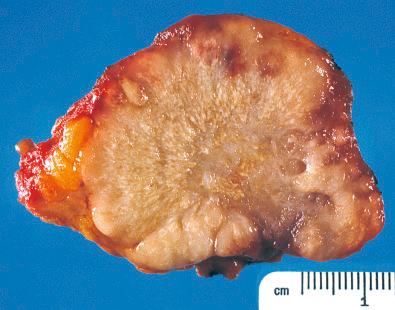
In general, the tumor presents as a rapidly growing, deeply located mass measuring 5 to 10 cm in greatest diameter. Superficially located cases occur but are uncommon. The tumor is painful in about one-third of cases. If peripheral nerves or the spinal cord are involved, there may be progressive sensory or motor disturbances. As with other round cell sarcomas, the preoperative duration of symptoms is usually less than 1 year. Unlike neuroblastoma, catecholamine levels are within normal limits. Computed tomography (CT), magnetic resonance imaging (MRI), and positron emission tomography (PET) are a routine part of the evaluation to determine anatomic relationships, the presence of distant disease, and the extent of therapeutic response to (neo) adjuvant therapy.
The gross appearance of the tumor varies. In general, it is multilobulated, soft, and friable, rarely exceeding 10 cm in greatest diameter. The cut surface has a gray-yellow or gray-tan appearance, often with large areas of necrosis, cyst formation, or hemorrhage. Despite the extensive necrosis, calcification is rare ( Fig. 33.1 ).
There is a spectrum of histologic change in the Ewing family of tumors; in the older literature, criteria distinguishing ES, so-called atypical ES (large cell variant), and PNET were varied. In a large clinicopathologic study of this family of tumors, based on morphologic criteria alone, Llombart-Bosch et al. classified 280 cases as conventional ES, 53 as PNET, and 80 as atypical ES. Because these lesions comprise a spectrum of histogenetically related tumors, the precise criteria for designating a tumor as an extraskeletal ES, atypical ES, or PNET are less critical. Therefore, cases across the spectrum can simply be classified as ES. The morphologic spectrum of this family of tumors is now known to include adamantinoma-like cases, keratin-positive tumors, and rare desmin-positive cases. As discussed later, cases with classic morphologic features can be accurately diagnosed using light microscopy with ancillary immunohistochemistry (IHC). However, given the wide morphologic spectrum, genetic confirmation is essential for the diagnosis of unusual morphologic variants, as well as in select circumstances (e.g., unusual immunophenotype, entry into clinical trial).
The histologic features of classic ES include a solidly packed, lobular pattern of strikingly uniform round cells ( Figs. 33.2 to 33.10 ). The individual cells have a round or ovoid nucleus with a distinct nuclear membrane, fine powdery chromatin, and one or two inapparent or small nucleoli. Multinucleated giant cells are not seen. The cytoplasm is poorly defined, scanty, pale staining, and in many cases irregularly vacuolated as a result of intracellular deposits of glycogen ( Figs. 33.5 and 33.6 ). Intracellular glycogen is present in most cases, but the amount varies from tumor to tumor and sometimes in different portions of the same neoplasm. Glycogen droplets may compress and indent the nucleus ( Fig. 33.6 ). The number of mitotic figures varies, and, in many cases, the paucity of mitotic figures contrasts with the immature appearance of the neoplastic cells.
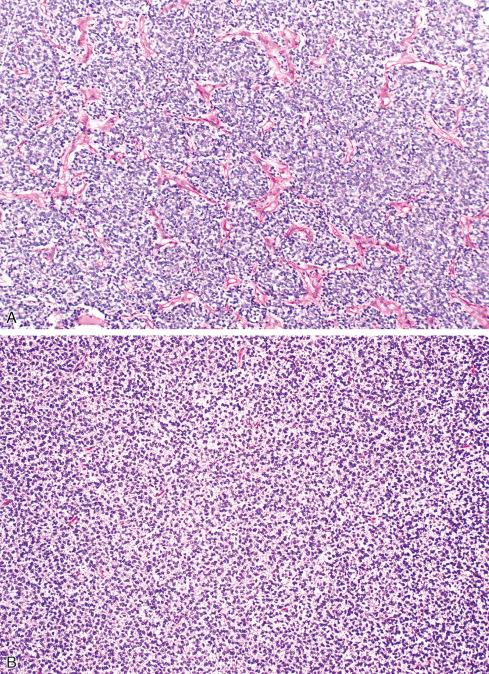
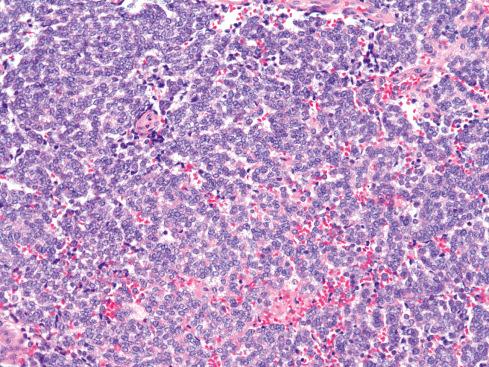
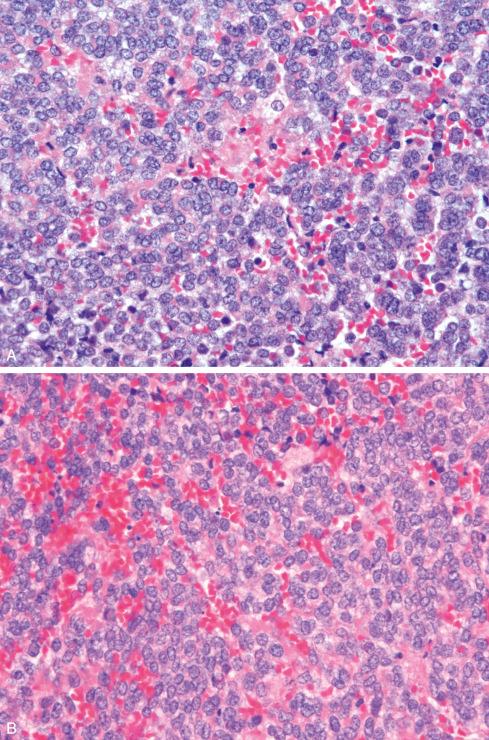
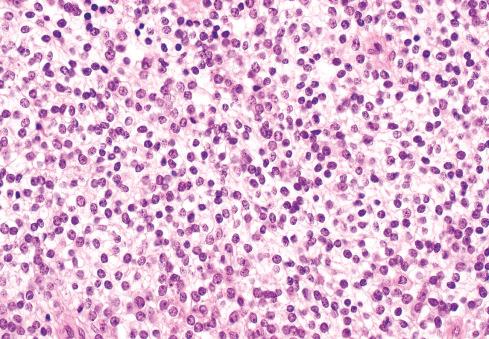
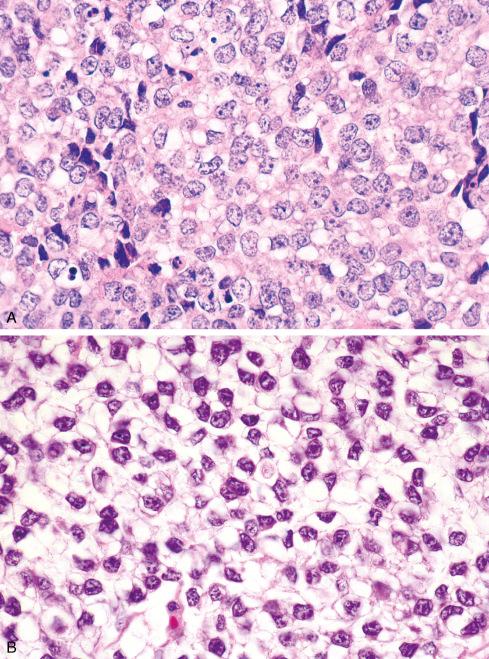
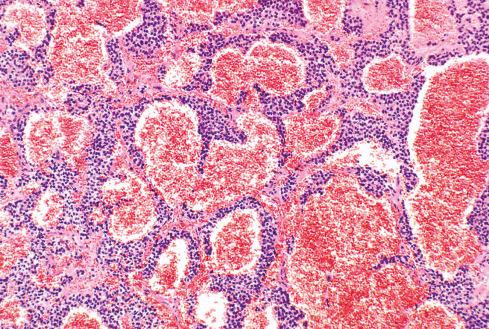
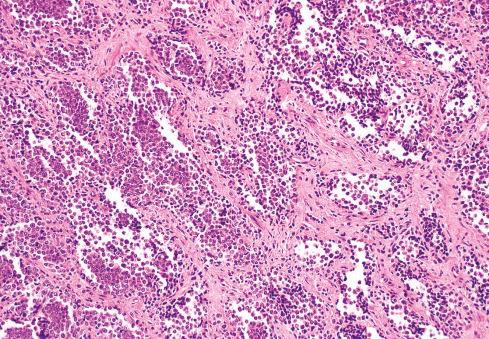
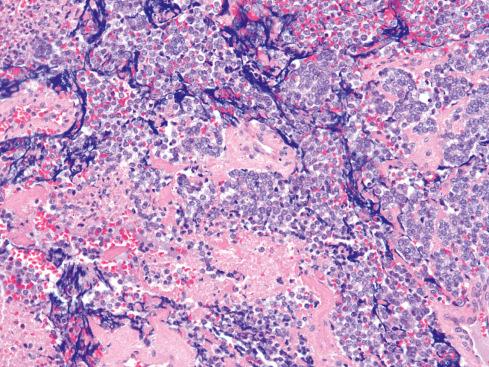
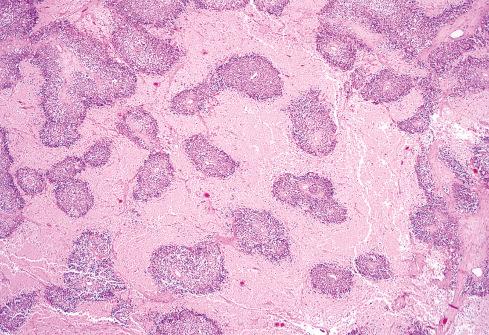
Although the tumor is richly vascular, the thin-walled vessels are compressed and obscured by the closely packed tumor cells; this rich vascularity is often discernible only in areas of degeneration and necrosis ( Fig. 33.8 ). The association of distinct vascular structures with degenerated or necrotic ghost cells is a common, striking feature ( filigree pattern ) ( Fig. 33.9 ). On occasion, ES may show a pseudovascular or pseudoalveolar pattern caused by small, fluid-filled pools or blood lakes amid the solidly arranged tumor cells ( Fig. 33.7 ). This feature occasionally is misinterpreted as evidence of angiosarcoma or alveolar rhabdomyosarcoma by those unfamiliar with this secondary change. Approximately 75% show these classic morphologic features. A minority of cases display moderate nuclear enlargement, irregular nuclear contours, and frequently prominent nucleoli, corresponding to the atypical or large cell variant of ES ( Figs. 33.11 and 33.12 ).
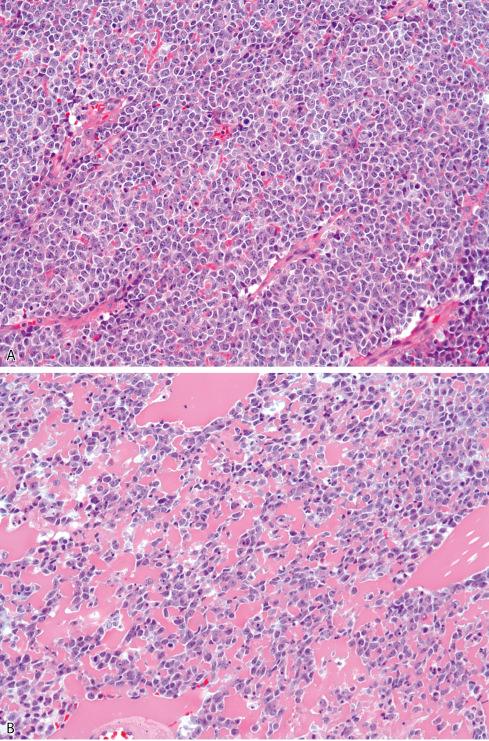
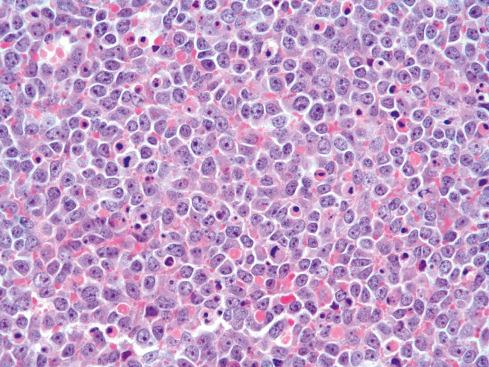
Perhaps the most difficult subtype of ES to recognize is the adamantinoma-like variant, described originally by Bridge et al. Adamantinoma-like tumors have accounted for up to 5% of cases in some consultation-based series of ES but are much less common in routine practice. These tumors show a distinctly nested, epithelioid growth pattern with striking stromal desmoplasia ( Fig. 33.13 ). The nests of tumor cells may display prominent peripheral nuclear palisading and contain large polygonal cells with irregularly contoured, hyperchromatic nuclei, prominent nucleoli, and moderate amounts of cytoplasm. Rarely, squamous pearls may be seen. Immunophenotypically, in addition to expressing markers of conventional ES (e.g., CD99, NKX2.2), adamantinoma-like ES typically show strong, uniform expression of pankeratins, including high-molecular-weight (HMW) keratins, as well as the basal cell/squamous cell–associated marker p40. Adamantinoma-like tumors most often harbor the EWSR1-FLI1 gene fusion.
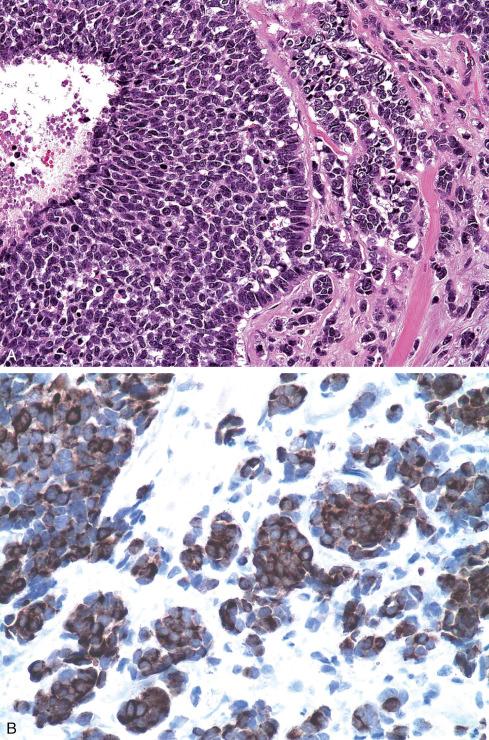
Approximately 15% of cases correspond to the previous designation of PNET and are composed of sheets or lobules of small round cells containing darkly staining, round or oval nuclei ( Figs. 33.14 and 33.15 ). The cytoplasm is indistinct, except in areas where the cells are more mature and the elongated, hairlike cytoplasmic extensions coalesce to form rosettes. Most of the rosettes are similar to those seen in neuroblastomas and contain a central solid core of neurofibrillary material ( Homer Wright rosette ). Rarely, the rosettes resemble those of retinoblastoma and contain a central lumen or vesicle ( Flexner-Wintersteiner rosette ). Rare cases of ES with extensive neural differentiation, including neuropil and ganglion cells resembling ganglioneuroblastoma, have been described. Some tumors are composed of cords or trabeculae of small round cells. These areas resemble a carcinoid tumor or a small cell undifferentiated carcinoma. However, histogenetically, they are properly compared to primitive neuroepithelium. Rarely, ES may show evidence of cartilaginous or osseous differentiation.
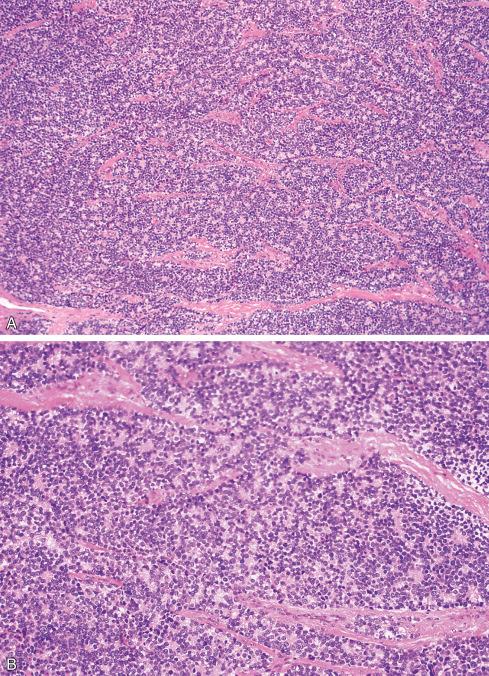
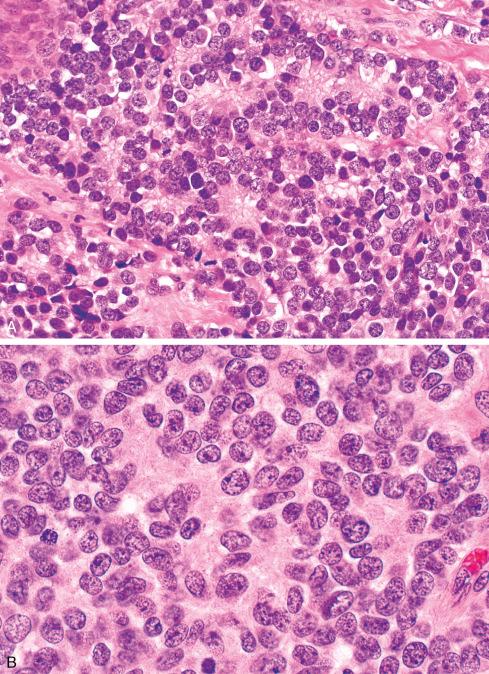
For many years, the diagnosis of ES was essentially an immunohistochemical diagnosis of exclusion. Beginning in the early 1990s, however, numerous studies confirmed the utility of the product of the MIC2 gene (CD99) in recognizing this group of tumors, confirming the high sensitivity of this marker for ES ( Fig. 33.16 ). The MIC2 gene is a pseudoautosomal gene located on the short arms of the sex chromosomes; its product is a membranous glycoprotein (CD99) that can be detected on IHC using a variety of antibodies, including 12E7, HBA71, and O13. Although initially believed to be highly specific for ES, it is now well recognized that most other round cell tumors in the differential diagnosis occasionally show membranous immunoreactivity for CD99 ( Table 33.1 ). These include lymphomas (particularly T-lymphoblastic lymphoma and precursor B-lymphoblastic lymphoma ), Merkel cell carcinoma, small cell carcinoma, rhabdomyosarcoma, small cell osteosarcoma, desmoplastic small round cell tumor, mesenchymal chondrosarcoma, and CIC -rearranged sarcomas. Notably, childhood neuroblastomas do not express CD99. Given the high sensitivity but poor specificity of CD99, it is best considered a “screening marker” for ES and should always be used as part of a panel of immunostains. The finding of patchy (or absent) CD99 expression in a “Ewing-like” round cell sarcoma should always raise concern for a CIC- or BCOR -rearranged tumor (see later).
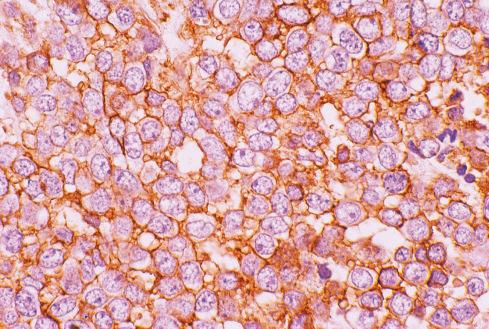
| CD99 | TdT | Myogenin | Desmin | NKX2.2 | ETV4 | WT1 | BCOR | DUX4 | |
|---|---|---|---|---|---|---|---|---|---|
| Ewing sarcoma | + | − | − | − | + | Rare (focal) | − | − | − |
| ARMS | 15% | − | + | + | − | − | − | − | − |
| Lymphoblastic lymphoma | >90% | + | − | − | − | − | − | − | − |
| DSRCT | 20% | − | − | + (dotlike) | 20% | 20% | + | − | − |
| CIC -rearranged sarcoma | 85% (patchy) | − | − | − | 5% | + | + | − | + |
| BCOR -rearranged sarcoma | 40% (patchy) | − | − | − | − | − | − | + | − |
Many ES also express neural markers, including neuron-specific enolase (NSE), CD57, S-100 protein, synaptophysin, and protein gene product 9.5 (PGP9.5). However, these markers lack specificity and are not particularly helpful in arriving at a diagnosis. The degree of immunohistochemical expression of neural markers has not been found to be predictive of clinical behavior, nor has their expression been found to be related to the specific EWSR1 gene fusion type.
Expression of epithelial markers in ES, in particular keratins, is a recognized diagnostic pitfall. Approximately 25% of tumors show aberrant keratin expression, usually confined to a small number of cells, and often showing a dotlike pattern of immunoreactivity. Typical ES expresses only low-molecular-weight (LMW) keratins. In contrast, the adamantinoma-like variant may show diffuse expression of keratins, including HMW isoforms, probably reflecting the complex epithelial differentiation seen in this variant. Adamantinoma-like ES may also express p40. Aberrant desmin expression is much less common in ES, present in only about 2% of cases. Desmin-positive Ewing sarcomas lack expression of MyoD1 and myogenin, distinguishing them from alveolar rhabdomyosarcoma.
As detailed later, FLI1, a member of the ETS family of DNA-binding transcription factors, is involved in the t(11;22) (EWSR1-FLI1) translocation frequently observed in ES. Polyclonal and monoclonal antibodies to FLI1 protein have been reported to show nuclear immunoreactivity in 70% to 94% of ES, including cases showing the less common EWSR1-ERG fusion gene. FLI1 immunoreactivity in EWSR1-ERG –positive cases likely reflects homology between the ERG and FLI1 proteins. IHC for FLI1 is not specific for ES and is also frequently positive in lymphoblastic and other non-Hodgkin lymphomas as well as in rare examples of melanoma, Merkel cell carcinoma, and neuroblastoma. Antibodies to ERG are more specific for tumors with ERG rearrangement, showing only rare positivity in cases with FLI1 rearrangements.
More recently, a number of studies have confirmed the utility of NKX2.2 as a marker of ES. NKX2.2 is a transcription factor that plays a role in neuronal development and glial or neuroendocrine differentiation and appears to be a downstream target activated by the EWSR1-FLI1 fusion. Immunoreactivity with NKX2.2 has been reported in up to 93% of ES cases, including those with EWSR1-FLI1 and EWSR1-ERG fusions, with most cases showing strong and diffuse nuclear staining. However, many other tumors in the differential diagnosis are also occasionally positive for this marker, including most mesenchymal chondrosarcomas and olfactory neuroblastomas, as well as rare CIC -rearranged sarcomas, poorly differentiated synovial sarcomas, neuroblastomas, and small cell carcinomas.
Given the therapeutic success of imatinib mesylate (Gleevec) in the treatment of gastrointestinal stromal tumor (GIST), there has been considerable interest in evaluating the expression of CD117 in other tumors, including ES. The frequency of CD117 expression in this tumor varies considerably, ranging from 20% to 71%. Very few cases of ES have been evaluated for KIT mutations, and the significance of CD117 expression in this tumor type is unclear.
The defining feature of ES is the presence of nonrandom translocations leading to the fusion of the EWSR1 gene on 22q12 with one of several members of the ETS family of transcription factors ( Fig. 33.17 ). The EWSR1-ETS gene fusions encode chimeric transcription factors that activate or repress target genes, as well as a number of epigenetic events that are central to the pathogenesis of ES. The most frequent of these translocations is t(11;22)(q24;q12), which is detected in approximately 85% of cases, and results in fusion of the 3′ end of the FLI gene on 11q24 with the 5′ end of the EWSR1 gene on 22q12. The second most common translocation, which is found in up to 10% of cases, is t(21;22)(q22;q12), leads to the fusion of EWSR1 to ERG at 21q22. Less common alterations (<5% of cases) result in the fusion of EWSR1 to ETV1 at 7p22, 76 ETV4 (also known as E1AF ) at 17q12, 77 FEV at 2q33, 78 and ZSG , resulting in an inv(22), among others. Very rarely, ES may show an EWSR1 fusion with non- ETS family members, including SMARCA5 , SP3 , NFATC2, and PATZ1. A small minority of ES show FUS gene rearrangements instead of EWSR1 rearrangements; such tumors are morphologically and immunohistochemically identical to EWSR1 -rearranged ES. The translocation breakpoints are restricted to introns 7 to 10 of the EWSR1 gene and introns 3 to 9 of the ETS -related genes. Fusion of EWSR1 exon 7 to FLI1 exon 6 ( type 1 fusion) and EWSR1 exon 7 to FLI1 exon 5 ( type 2 ) account for about 85% of EWSR1-FLI1 fusions. Detection of these fusions by molecular genetic techniques (FISH or RT-PCR) using fixed, paraffin-embedded tissues has greatly facilitated the diagnosis of ES. One should keep in mind that EWSR1 and FUS gene rearrangements occur in many other sarcomas (see Chapter 4 ), and these molecular tests should always be interpreted in combination with other morphologic and immunohistochemical findings.

Secondary cytogenetic abnormalities may occur in ES, including trisomy 8, trisomy 12, 89 and an unbalanced t(1;16) leading to gain of 1q and loss of 16q. These cytogenetic abnormalities lack sufficient sensitivity and specificity for diagnostic purposes, but some have suggested a prognostic role. In addition, alterations in TP53 and p16/p14ARF are detected in up to 25% of Ewing sarcomas; these alterations are detected in a subset of chemotherapy-refractory tumors, and are associated with an aggressive clinical course.
Until the introduction of modern therapy, the outlook for patients with ES was bleak, and only a small percentage of patients with this tumor survived. For example, in the series of extraskeletal ES reported by Angervall and Enzinger in 1975, 22 of the 35 patients with follow-up information died of metastatic disease, usually to the lung and skeleton. Similarly, Jürgens et al. cited a survival rate of approximately 50% at 3 years, whereas Kushner et al. found that only 25% of patients with tumors larger than 5 cm were alive at 24 months. Although several older studies suggested that patients with PNET had a worse prognosis than those with extraskeletal ES, others have not found this to be the case. Parham et al. studied 63 Ewing sarcomas from patients who were treated uniformly to determine the prognostic significance of neuroectodermal differentiation. Tumors were classified as PNET if they showed rosettes or immunohistochemical expression of at least two neural markers (or both). Using another classification scheme, tumors were classified as PNET if they showed rosettes or immunohistochemical expression of at least four neural markers (or both). Finally, using a third classification scheme, tumors that showed ultrastructural evidence of neural differentiation were classified as PNET. Using any of these classification schemes, no significant differences in clinical outcome for patients with or without neuroectodermal differentiation were noted. As such, distinction of ES from PNET is no longer clinically relevant.
The prognosis for patients with ES has steadily improved. About 75% of patients present with localized disease, along with the combination of surgery and/or radiotherapy and systemic chemotherapy results in a cure rate of almost 75% in this group. However, little progress has been made for patients who present with metastatic disease. The role of megatherapy (myeloablative high-dose chemotherapy, with or without total body irradiation followed by stem cell infusion) in the treatment of metastatic disease remains unclear. A number of clinical trials through the Children’s Oncology Group (COG) and European Cooperative Groups continue to assess new potentially more efficacious protocols. With increased understanding of the molecular pathways, opportunities for targeted therapy have emerged. Potential targets can be broadly classified into those related to the EWSR1-ETS fusion (e.g., trabectedin, lurbinectedin ), receptor tyrosine kinases and associated signaling pathways (e.g., IGFR, PDGF ), the TP53 and retinoblastoma pathways, angiogenesis, and apoptosis. Minimal residual disease can be detected in peripheral blood or bone marrow by RT-PCR, and detection of fusion transcript-positive cells in the blood seems to predict disease progression.
Key prognostic factors that adversely influence the outcome of the disease are the presence of metastatic disease at the initial diagnosis, large tumor size, extensive necrosis ( filigree pattern ), central axis tumors, and poor response to initial chemotherapy. Several studies have found that the type of EWSR1-FLI1 fusion may be prognostically relevant; patients with type 1 fusions have been reported to have longer disease-free survival, lower proliferative rates, and better chemotherapeutic response than those with other fusion types. However, another study found no significant clinical differences between those with EWSR1 - FLI1 and those with EWSR1 - ERG fusions. Several studies have identified gene expression profiles associated with the presence of metastases, prognosis, and response to therapy.
A subset of small round blue cell tumors closely resembling ES but lacking aberrations of EWSR1 has been delineated over the past few years, many of which show rearrangement of the CIC gene on 19q13. Some of these tumors have a t(4;19)(q35;q13.1) involving the DUX4 and CIC genes on chromosomes 4 and 19, respectively, whereas others show a t(10;19) involving a gene on chromosome 10q26, which is highly homologous to the DUX4 gene on 4q35. Although referred to in the most recent World Health Organization (WHO) classification as “Ewing-like sarcoma,” it is clear that CIC -rearranged sarcomas account for the majority (60%–70%) of these Ewing-like tumors.
These tumors generally arise in young patients, with a peak in the third decade of life, although there is a wide age distribution. In the largest study (115 patients) published to date, patients ranged in age from 6 to 81 years (mean: 32). CIC -rearranged sarcomas have a slight male predilection and most often occur in the deep soft tissues of the extremities, followed by the trunk and head/neck. About 12% of tumors arise in visceral organs, especially the kidney. Very few cases arise as primary lesions in bone. Patients typically present with a slowly enlarging, painless soft tissue mass.
CIC -rearranged sarcoma most closely resembles ES and generally is composed of small round cells with vesicular nuclei, fairly prominent nucleoli, and amphophilic to slightly eosinophilic cytoplasm. The cells are often arranged into distinct lobules ( Fig. 33.18 ), and extensive areas of geographic necrosis are typical ( Fig. 33.19 ). Mitotic figures, including atypical mitotic figures, are easily identified. The cells tend to show more nuclear pleomorphism than is seen in classic ES ( Figs. 33.20 to 33.22 ). Less common features include cytoplasmic clearing, myxoid stroma, spindle cell areas, and occasionally large epithelioid or rhabdoid cells.
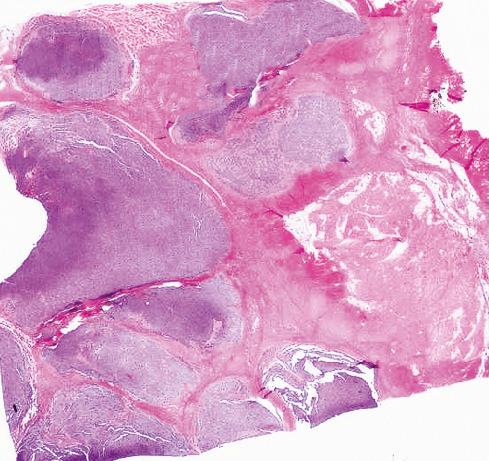
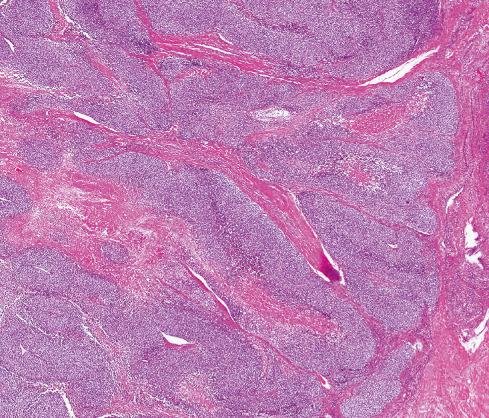
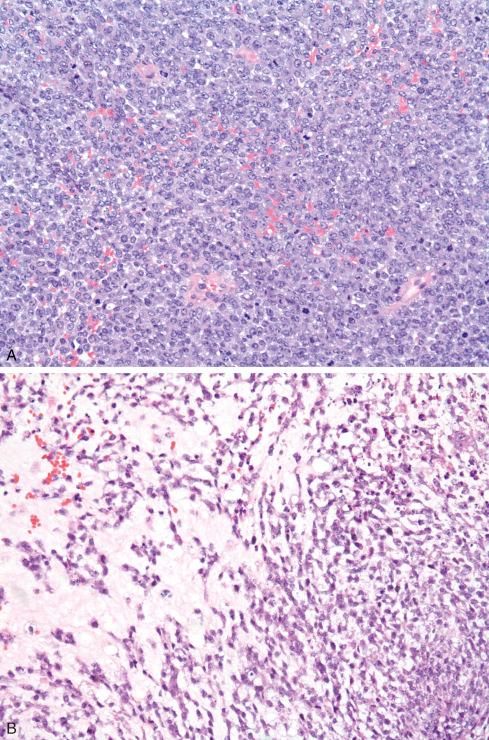
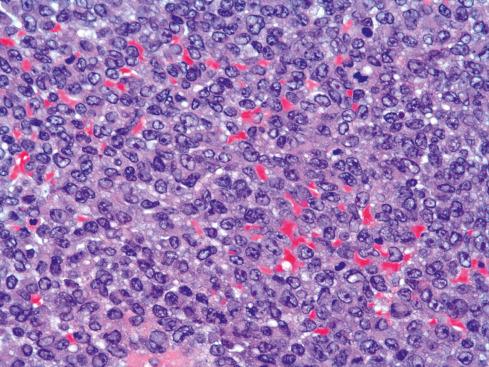
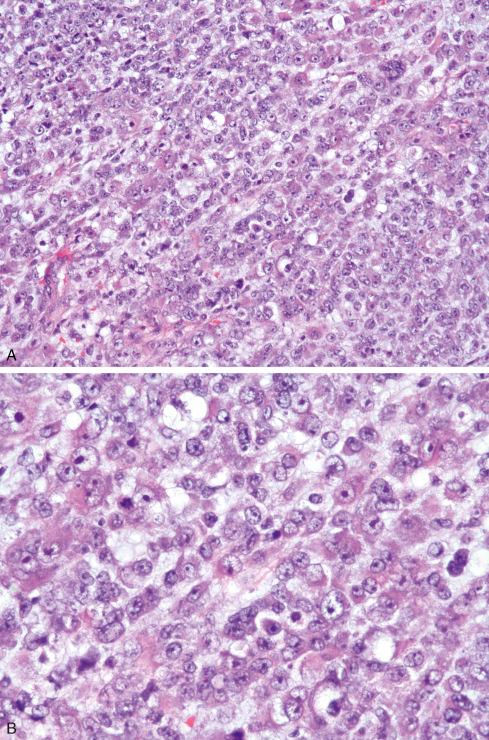
On IHC, most cases (up to 85%) express CD99. However, unlike ES, the pattern is typically patchy rather than diffuse ( Fig. 33.23 ). As previously noted, absent or patchy CD99 expression in a Ewing-like sarcoma should suggest CIC -rearranged sarcoma. Unlike ES, this tumor is usually negative for NKX2.2. However, both tumors are often FLI1 positive. 132 Some CIC -rearranged sarcomas are ERG positive. A role for calretinin (expressed in 70% of CIC-rearranged sarcomas but not in ES) has been suggested.
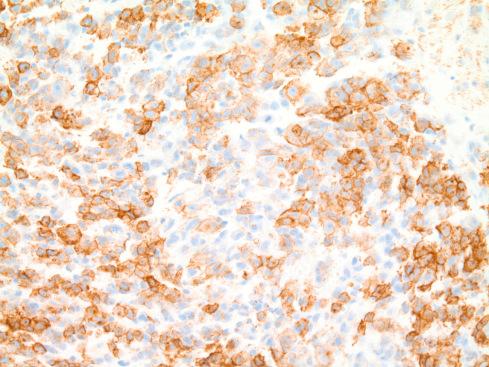
Gene expression studies of CIC -rearranged sarcomas have consistently noted upregulation of the PEA3 family of genes, including ETV1, ETV4, and ETV5 . Subsequently, several immunohistochemical studies have shown a high degree of sensitivity and specificity for ETV4 IHC, with diffusely nuclear immunoreactivity in CIC -rearranged sarcomas but only occasional weak reactivity in ES. More recently, RNA in situ hybridization for ETV1/4/5 has also been found to have a high degree of sensitivity and specificity (perhaps even better than IHC). IHC for WT1 protein, using both amino- and carboxy-terminus antibodies, has also been shown to be a highly sensitive, if imperfectly specific, marker of CIC-rearranged sarcomas. There may also be a role for DUX4 IHC in this differential diagnosis; DUX4 expression has been shown to be a consistent feature of CIC -rearranged sarcomas, but not other round cell tumors.
This family of tumors is defined by the presence of a CIC gene rearrangement, either with 4q35 or 10q26.3. The CIC-DUX4 gene fusion can be detected by either RT-PCR or FISH, using either frozen or paraffin-embedded tissues. Several studies have emphasized a small but definite false-negative rate (up to 15%) using a CIC break-apart FISH probe. Rarely, alternate fusion partners have been reported, including a CIC-NUTMTA fusion and CIC-FOXO4 fusion. Antonescu et al. found the CIC-DUX4 fusion in 57% of tested cases, with either DUX4 on 4q35 (35%) or 10q26 (22%); no FOXO4 rearrangements were identified.
CIC aberrations have recently been identified in a small number of very unusual, nonvasoformative, epithelioid malignant neoplasms. They show expression of endothelial markers (CD31 and FLI1) and occur in the soft tissues of young adults. These tumors are discussed in Chapter 22 .
CIC -rearranged sarcomas have now been clearly delineated as the most common type of “Ewing-like” sarcoma, with histologic, immunohistochemical, and molecular genetic features that distinguish it from ES and all other round cell sarcomas ( Table 33.2 ). Its recognition is important because it appears to be more clinically aggressive than ES. Before the study of Antonescu et al. in 2017, clinical data on this tumor were limited to small retrospective series. These tumors usually follow an aggressive clinical course with high rates of metastasis and a lower sensitivity to ES chemotherapeutic protocols, with a 5-year survival of only 43% (vs. 77% in ES). CIC -rearranged sarcomas also reportedly more often present with disseminated disease, show greater chemoresistance, and have a poorer overall survival than conventional ES.
| CIC- Rearranged Sarcoma | BCOR- Rearranged Sarcoma | |
|---|---|---|
| Age | Wide age distribution; peak in adolescents and young adults | Peak in adolescents and young adults; male predominance |
| Site | Soft tissues of extremities; rare in bones | Common in bone |
| Immunophenotype | Variable CD99; ETV4+; WT1+; DUX4+ | Variable CD99; BCOR+; CCNB3+ (if CCNB3 fusion) |
| Fusion partners | DUC4 , FOXO4 , NUTM1 | CCNB3 , BCOR internal tandem duplication, MAML3 , ZC3H7B |
| Survival | Very poor | 75% 5-year survival |
Among the “Ewing-like” sarcomas, those with BCOR rearrangements are much less common than CIC -rearranged sarcomas, accounting for approximately 10% of Ewing-like sarcomas. This group of tumors was first identified in 2012 as part of an RNA-sequencing screen for EWSR1 fusion–negative tumors. Subsequent studies further delineated the clinical, morphologic, immunohistochemical, and molecular genetic features of this family of tumors.
BCOR -rearranged sarcoma mainly affects adolescents and young adults, although the age distribution is wide. In the largest study to date, patients ranged in age from 2 to 44 years, with a mean and median age of 15 years, with a striking male predominance (31 of 36 patients; 86%). Although other studies showed a strong predilection for this tumor to arise in both long and flat bones, more recent studies report that up to 44% of tumors arise in the soft tissues or viscera, particularly the kidney. Within the soft tissues, BCOR -rearranged tumors have been reported in the trunk, extremities, and head/neck.
Grossly, the tumors most often measure between 8 and 15 cm at excision, usually with a fleshy appearance, and often with grossly identifiable areas of necrosis. BCOR -rearranged sarcomas show a wide range of morphologic features, resulting in a broad differential diagnosis that includes both round cell and spindle cell sarcomas, depending on the predominant cytologic features in a given case ( Figs. 33.24 and 33.25 ). Many show an admixture of uniform, medium-sized round cells admixed with spindled cells, but some cases show an exclusively round cell or spindle cell appearance. The cells may be arranged in sheets, whorling fascicles, or even long fascicles imparting a herringbone appearance. The nuclei have fine chromatin and small, indistinct nucleoli. Mitotic figures usually are easily seen. The stroma can range from myxoid to fibrous, and areas of hemorrhage and necrosis are common. A rich capillary network is usually present.
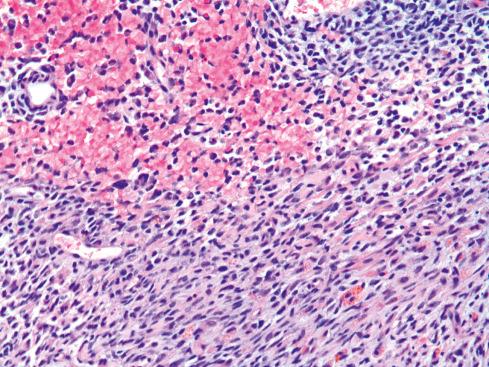
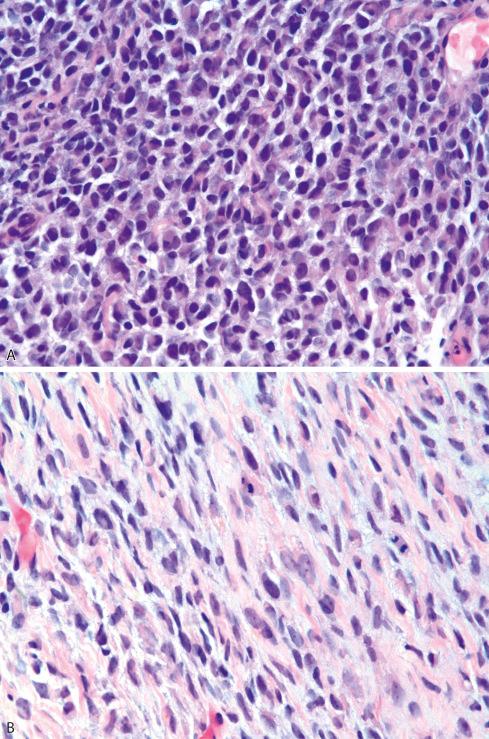
CD99 expression is variable from case to case and even within the same tumor. Overall, about 40% of cases express this antigen. Many also express SATB2, which potentially can cause confusion with small cell osteosarcoma. TLE1 expression is present in 80%, potentially resulting in confusion with synovial sarcoma. These tumors typically do not express keratins, S-100 protein, SOX10, melanocytic, or myoid markers. As discussed next, most of these tumors harbor a BCOR-CCNB3 fusion, resulting in expression of both BCOR and CCNB3 , which can be detected on IHC. Nuclear CCNB3 immunoreactivity is found in most BCOR -rearranged sarcomas and appears to be highly specific, although cytoplasmic staining may be seen in some tumors, including ES, alveolar rhabdomyosarcoma, and synovial sarcoma. Nuclear BCOR immunoreactivity is also a highly sensitive, but not entirely specific, marker of this tumor; although present in all BCOR -rearranged sarcomas it is also in some Ewing, CIC -rearranged, and synovial sarcomas.
The majority of these tumors harbor a BCOR-CCNB3 fusion that can be detected by FISH or RT-PCR. Both genes are located on chromosome X, and inversions of both with fusion of the 5′ centromeric region of BCOR (exon 15) with the 3′ centromeric region of CCNB3 (exon 15) are usually seen. Several alternate fusions have been described, including BCOR-MAML3 , ZC3H7B-BCOR, and KMT2D-BCOR . Interestingly, the same ZC3H7B-BCOR fusion has been described in endometrial stromal sarcoma and ossifying fibromyxoid tumor.
The relationship among a number of tumors has yet to be fully elucidated, including clear cell sarcoma of kidney, primitive myxoid mesenchymal tumor of infancy, infantile soft tissue undifferentiated round cell sarcoma, and BCOR-CCNB3 fusion sarcomas. However, there is clearly a considerable morphologic, immunohistochemical, and molecular genetic overlap between these entities. In particular, many of these tumors have been reported to harbor recurrent BCOR exon 16 internal tandem duplications (ITDs) and YWHAE-NUTM2B fusions, suggesting that these are all part of a spectrum of histogenetically related tumors.
BCOR -rearranged sarcomas seem to have a clinical course not too dissimilar from ES but less aggressive than CIC -rearranged sarcoma. In the study by Kao et al., follow-up on 22 patients showed a 5-year overall survival of 72%, similar to patients with ES (79%), but significantly better than patients with CIC -rearranged sarcoma (43%). Six patients developed local recurrences, and four developed metastatic disease (lung, pancreas, bone, and soft tissue sites). Seven of nine patients treated with an ES chemotherapeutic protocol showed a significant posttherapeutic response in their resection specimen. Others have reported similar results.
In addition to being distinguished from each other, Ewing sarcomas, CIC-rearranged sarcomas, and BCOR-rearranged sarcomas must be distinguished from many other round cell malignancies of mesenchymal and nonmesenchymal origin. As noted, CIC - and BCOR -rearranged sarcomas tend to show greater nuclear variability and more prominent nucleoli than does ES, and may show myxoid change with rhabdoid/epithelioid cytology. Patchy or weak expression of CD99 should always suggest CIC - or BCOR -rearranged sarcomas, as should strong immunoreactivity for WT1, SATB2, or TLE1. IHC for DUX4, ETV4, and BCOR may also be very helpful; molecular genetic testing for EWSR1, CIC, and BCOR rearrangements is confirmatory.
Neuroblastoma tends to occur in younger children (compared to ES or CIC - and BCOR -rearranged sarcomas), and essentially always occurs in a midline, paravertebral location in association with sympathetic ganglia. Elevated urinary catecholamines are typically seen in neuroblastoma patients. Microscopically, the cells of neuroblastoma tend to be smaller and more uniform than those of ES or the Ewing-like sarcomas. In addition, neuropil production and ganglionic differentiation are frequently present. Neuroblastomas express synaptophysin, chromogranin A, and CD56, but not CD99.
Alveolar rhabdomyosarcoma usually shows distinctive pseudoalveolar architecture, with fibrovascular septa surrounding discohesive nests of rounded blue cells. Solid forms may occur, however, and are more difficult to diagnose. The presence of occasional cells with brightly eosinophilic cytoplasm and multinucleated giant tumor cells should suggest alveolar rhabdomyosarcoma. Desmin and myogenin expression is typically diffuse and confirms the diagnosis. CD99 expression may be present, emphasizing the need to use this marker as part of an immunohistochemical panel. Demonstration of the alveolar rhabdomyosarcoma–specific PAX3/PAX7-FOXO1A fusion is confirmatory.
Desmoplastic small round cell tumor (DSRCT) typically presents in young adults, usually men, as a large intraabdominal mass with multiple peritoneal implants. Histologically, it is composed of sharply outlined islands of round blue cells separated by a desmoplastic stroma containing myofibroblasts and numerous small vessels. Although DSRCT may express CD99 and WT1, as in CIC - or BCOR -rearranged sarcoma, it is characterized by coexpression of keratins, desmin, and vimentin, a feature not seen in ES or the Ewing-like sarcomas. Importantly, DSRCT also shows EWSR1 rearrangements, in the form of the EWSR1-WT1 fusion. Thus, FISH for EWSR1 is not helpful in this differential diagnosis, and RT-PCR is required.
Poorly differentiated synovial sarcoma (PDSS) is composed of small round to somewhat spindled cells, often arranged around a hemangiopericytoma-like vasculature. Wiry collagen is often present, a helpful clue. PDSS represents a form of progression in monophasic or biphasic synovial sarcoma, and careful inspection for less primitive-appearing foci may be helpful. IHC is not always helpful in the distinction of PDSS, because it frequently expresses CD99 and may be keratin negative. Diffuse TLE1 expression is characteristic, however, and this finding should prompt molecular genetic studies for the synovial sarcoma–specific SS18-SSX1/SSX2 fusions (discussed later). It should be kept in mind that TLE1 expression is also typically seen in BCOR -rearranged sarcomas.
Although the spindled and round cell zones of mesenchymal chondrosarcoma may resemble ES or one of the Ewing-like sarcomas, the presence of foci of cartilage, and sometime bone, production is diagnostic. IHC generally plays little role in the diagnosis of mesenchymal chondrosarcoma. CD99 expression is a potential pitfall. Demonstration of the HEY1-NCOA2 fusion is diagnostic of mesenchymal chondrosarcoma.
Small cell osteosarcoma , a rare variant of osteosarcoma, typically occurs in young patients and is composed of cells somewhat similar to those seen in ES. The diagnosis can only be made if osteoid is identified, but osteoid may be only focally present in the tumor and is often not identified in small biopsy specimens. IHC generally plays little role in the diagnosis of small cell osteosarcoma, although there may be a role for SATB2. It should be remembered that CD99 expression may be seen in small cell osteosarcoma, and SATB2 expression is often found in BCOR -rearranged sarcomas.
Lastly, ES and Ewing-like sarcoma should be distinguished from nonmesenchymal round cell tumors, in particular lymphoma, including lymphoblastic lymphoma, and small cell neuroendocrine carcinoma. In general, a panel of immunostains to include CD45, TDT, and CD10 will allow confident recognition of lymphoma/leukemia, keeping in mind that lymphoblastic lymphomas are usually CD99 and FLI1 positive. Particularly in older adults, one should be reluctant to diagnose ES or a Ewing-like sarcoma until small cell carcinoma (including Merkel cell carcinoma) has been excluded. Diffuse expression of synaptophysin or chromogranin A is much more characteristic of small cell carcinoma , since ES is typically either negative for these markers or at most focally positive. Merkel cell carcinoma also typically expresses keratin 20 and Merkel cell polyomavirus large T antigen. Expression of CD99 is uncommon in small cell carcinoma.
Extraskeletal myxoid chondrosarcoma (EMC) is a morphologically distinctive neoplasm. With a multinodular architecture it is characterized by cords or clusters of chondroblast-like cells deposited in an abundant myxoid matrix. The WHO categorizes EMC as a tumor of uncertain differentiation because there is a paucity of convincing evidence of cartilaginous differentiation. EMC occurs primarily in the deep tissues of the extremities, especially the musculature. Because myxoid chondrosarcomas of bone can resemble EMC to a degree, imaging modalities are necessary to establish its soft tissue origin. Tumors identical to EMC can also rarely occur in bone. It is a relatively slow-growing tumor but has a propensity for local recurrence and eventually pulmonary metastasis, sometimes many years after the initial diagnosis.
This tumor is quite uncommon and accounts for less than 3% of all soft tissue sarcomas. EMC usually arises in patients older than 35 years, and only a few cases have been encountered in children and adolescents. Most series have found a peak incidence during the fifth or sixth decade. Men are affected about twice as often as women. The clinical signs and symptoms are nonspecific. Most patients present with a slowly growing, deep-seated mass that causes pain and tenderness in approximately one-third of cases. Complications such as ulceration and intratumoral hemorrhage may be encountered with large tumors. The duration of symptoms varies considerably, ranging from a few weeks to several years. Some patients have a history of trauma before discovery of the tumor, but as with other sarcomas, the significance of this finding remains uncertain and is, in all likelihood, coincidental.
More than two-thirds of cases occur in the proximal extremities and limb girdles, especially the thigh and popliteal fossa similar to myxoid liposarcoma. Most are deep seated, although occasional tumors are confined to the subcutis; the latter may be difficult to distinguish from myxoid forms of chondroma or myoepithelial tumors. Rare examples have been described in unusual locations, including the lung, heart, and vulva. Radiography, CT, and MRI simply show a soft tissue mass with no distinctive radiologic features that would set the tumor apart from other types of soft tissue sarcoma.
Macroscopically, the neoplasm is a soft to firm, ovoid, lobulated to nodular, circumscribed mass surrounded by a dense fibrous pseudocapsule. On section, it has a gelatinous, gray to tan-brown surface. However, its color largely dependent on the extent of hemorrhage, a frequent feature of the tumor ( Fig. 33.26 ). Occasionally, hemorrhage is so prominent that the tumor is mistaken for a hematoma. Hematoidin pigment is often identified and may be a good clue to look closely for small nodules of tumor, especially in masses otherwise resembling an old, fibrotic hematoma. Highly cellular higher-grade tumors often have a fleshy consistency. The size of the tumor varies from a few centimeters to 15 cm or more, although most are 4 to 7 cm in greatest diameter at excision (range: 1.1-25.0 cm).
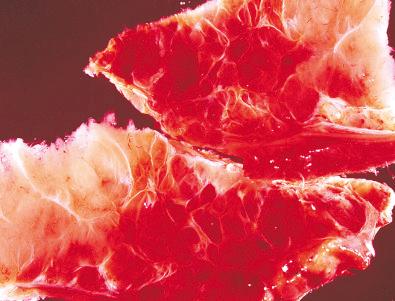
Microscopically, a characteristically multinodular pattern is clearly evident at low magnification ( Fig. 33.27 ). The individual tumor nodules consist of round or slightly elongated cells of uniform shape and size separated by variable amounts of mucoid material ( Figs. 33.28 and 33.29 ). The individual cells have small hyperchromatic nuclei and a narrow rim of deeply eosinophilic cytoplasm reminiscent of chondroblasts ( Fig. 33.30 ). Occasional cells show cytoplasmic vacuolization. Unlike chondrosarcoma of bone, differentiated cartilage cells with distinct lacunae are not seen in EMC. Mitotic figures are usually rare but may be numerous in less well differentiated and more cellular forms of the tumor.
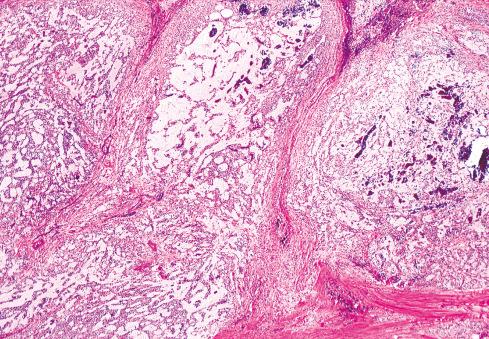
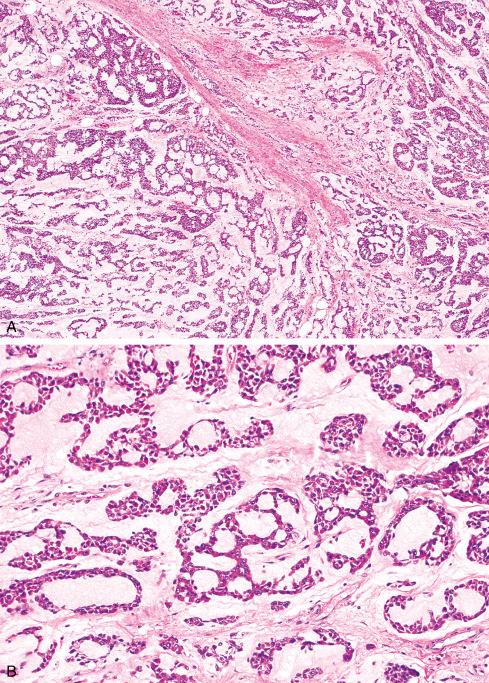
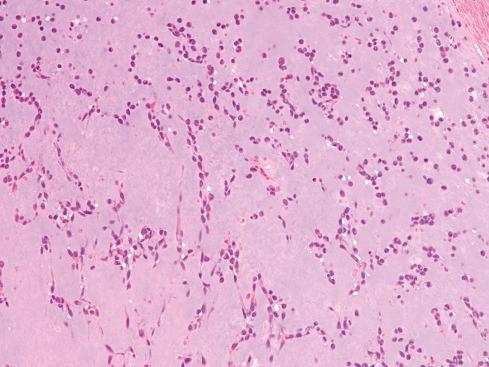
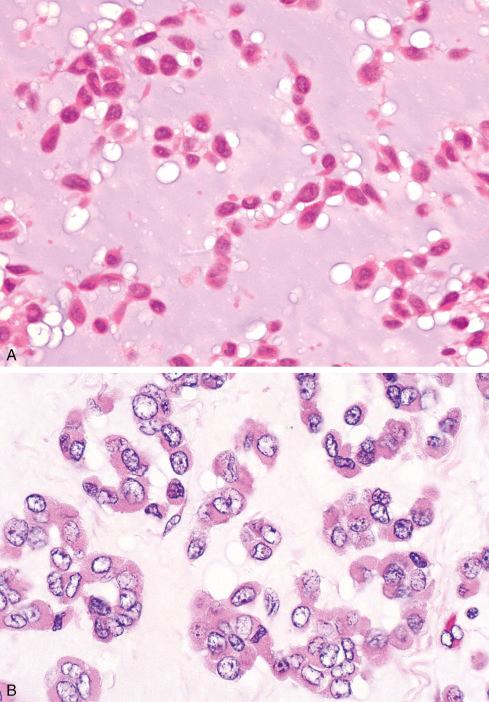
Characteristically, the individual cells are arranged in short anastomosing cords, strands, or pseudoacini, often creating a lacelike appearance. Less frequently, the cellular elements are organized in small, loosely textured whorls or aggregates, reminiscent of an epithelial neoplasm. Rarely, cellular foci composed of fibroblastic/myofibroblastic spindle-shaped cells are present. Indeed, if these features prevail throughout the tumor, a definitive diagnosis of EMC may be exceedingly difficult. Although most EMCs are highly myxoid tumors, a distinct subset is hypercellular with less myxoid stroma between the neoplastic cells and composed of sheets of large cells with vesicular nuclei and prominent nucleoli (i.e., cellular variant of extraskeletal myxoid chondrosarcoma ) ( Fig. 33.31 ). These tumors are best diagnosed by identifying typical less cellular areas of EMC or by cytogenetics/molecular genetics (discussed later). Some tumors are composed of a cellular proliferation of relatively small round cells closely resembling Ewing sarcoma. Even more rarely, typical EMCs are associated with or progress to a high-grade pleomorphic sarcoma ( dedifferentiated extraskeletal myxoid chondrosarcoma ), and still others may have rhabdoid features characterized by cells with large, paranuclear hyaline inclusions. These tumors often show loss of SMARCB1 195 and tend to have variant fusions (non– EWSR1-NR4A3 ). Secondary changes such as fibrosis and hemorrhage are common, but calcification or bone formation is rare.
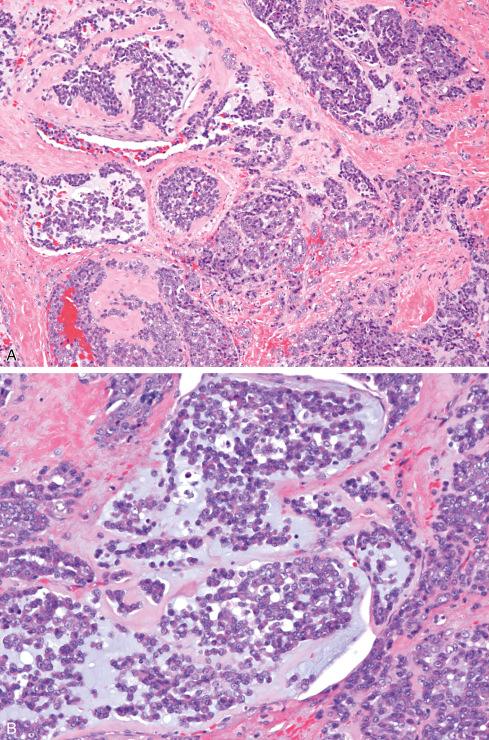
The cells of extraskeletal myxoid chondrosarcoma stain strongly for vimentin, but this is the only marker that is consistently positive. In contrast to true chondroid neoplasms, the majority of EMCs show an absence or only focal staining for S-100 protein; SOX10 is typically negative. As with many other types of sarcoma, rare cases show focal immunoreactivity for keratins. In addition, almost 30% of EMCs show scattered cells that are EMA positive, potentially resulting in confusion with a soft tissue myoepithelial tumor. Some authors have found evidence of neuroendocrine differentiation (via expression of NSE, chromogranin, or synaptophysin), and identification of dense-core granules on ultrastructural examination. Interestingly, the presence of neuroendocrine features has been associated with the relatively uncommon t(9;17)(q22;q11). Others have found these cells to express microtubule-associated protein-2 (MAP2) and class III β-tubulin, which are components of microtubules and are specifically localized in neurons and their derivatives. This has been taken as further evidence of neuroendocrine differentiation in at least some examples of EMC. More recently, the majority of EMCs have been found to express INSM1, a zinc-finger transcription factor that plays an important role in neuroendocrine differentiation, providing further evidence for this line of differentiation. Tumors with rhabdoid features typically show loss of SMARCB1 (INI1). Up to 30% of cases show positivity for CD117.
Extraskeletal myxoid chondrosarcoma is characterized most frequently (up to 75% of cases) by a balanced t(9;22)(q22;q12), which fuses EWSR1 with NR4A3 (previously known as NOR1, CHN, or TEC ). Variant translocations include a t(9;17)(q22;q11) that results in a TAF15 (also known as RBP56 or TAF2N ) fusion with NR4A3, a t(9;15)(q22;q21) resulting in a TCF12-NR4A3, or a t(3;9)(q12;q22) resulting in an TFG-NR4A3 fusion. Recently, the HSPA8-NR4A3 fusion has also been reported. As found with other EWSR1 -rearranged sarcomas, rarely an FUS rearrangement can be detected ( FUS-NR4A3 ). These genetic events are not found in conventional myxoid chondrosarcoma of bone. Tumors morphologically and genetically identical to EMC, however, may occur in bone and have been termed “osseous myxochondroid sarcoma.” Molecular assays using paraffin-embedded tissues (RT-PCR or FISH) can be extremely helpful in confirming this diagnosis using probes to NR4A3 and EWSR1 .
Interestingly, non– EWSR1-NR4A3 variant fused tumors have been associated with high-grade morphologic features, including high cellularity, increased cytologic atypia, and rhabdoid morphology. In contrast, EWSR1 -rearranged tumors usually show low cellularity, minimal cytologic atypia, low mitotic counts, and indolent clinical behavior.
The molecular consequences of these translocations are now being unraveled. Expression profiling studies have identified potential downstream targets, including DKK1, NMB, DNER, CLCN3, RET, and DEF6. Several studies, including an expression profiling study of genetically confirmed cases, have found high levels of expression of peroxisome proliferator-activated receptor-γ ( PPARG ), a potential therapeutic target.
Probably the most difficult tumor to distinguish from extraskeletal myxoid chondrosarcoma is the family of benign and malignant myoepithelial tumors ( myoepithelioma and myoepithelial carcinoma ). These tumors display a curious modulation between epithelioid and spindled areas. The immunophenotype of deeply situated myoepithelial lesions usually involves coexpression of several markers, including keratins and epithelial membrane antigen (EMA), S-100 protein, calponin, and sometimes p63 and glial fibrillary acidic protein (GFAP) ( Table 33.3 ). However, it must be kept in mind that up to 50% of these tumors harbor EWSR1 aberrations that can add further confusion in its distinction from EMC. Thus, detection of NR4A3 aberrations can be more helpful in separating these tumors.
| Tumor | LMW Keratins | K7 | K19 | EMA | S-100 | CEA | Actin |
|---|---|---|---|---|---|---|---|
| EMC | − | − | − | − | ± | − | − |
| Chordoma | + | ± | + | + | + | + | − |
| Myxoid liposarcoma | − | − | − | − | ± | − | − |
| Myoepithelioma | + | − | − | + | + | − | ± |
Myxoma and myxoid liposarcoma must also be considered in the differential diagnosis ( Table 33.4 ). Myxoma displays a similar paucity of vascular structures, but it is less cellular than EMC; the cytologically bland cells of myxoma are separated by abundant myxoid stroma. Myxoid liposarcoma , on the other hand, displays a strikingly plexiform vascular pattern and contains lipoblasts, especially at the margin of the tumor lobules. S-100 protein is found in approximately 40% of myxoid liposarcomas and does not help distinguish this tumor from EMC. In difficult cases, molecular genetic analysis (RT-PCR or FISH) to evaluate for aberrations of EWSR1, NR4A3, FUS, and DDIT3 can be quite helpful. However, it must be kept in mind that FUS rearrangements (common in myxoid liposarcoma) may rarely be seen in EMC. In addition, EWSR1 rearrangements (common in EMC) may occasionally be identified in myxoid liposarcoma.
| Diagnosis | Cellularity | Vascularity | Pleomorphism | Matrix |
|---|---|---|---|---|
| Myxoma | 1+ | 1+ | 0 | HA |
| Myxoid liposarcoma | 1+ | 3+ (fine) | 1+ | HA |
| Myxofibrosarcoma | 1+ to 2+ | 3+ (coarse) | 2+ to 3+ | HA |
| EMC | 1+ (cords) | 1+ | 1+ | CS |
EMC may be difficult to distinguish from a number of benign or malignant chondroid or myxoid lesions, including the myxoid variant of extraskeletal (soft part) chondroma. Extraskeletal chondromas usually occur in the soft tissues of the hands or feet—unusual locations for EMC. They tend to be smaller, less cellular lesions without evidence of EWSR1 or NR4A3 aberration. Chondromyxoid fibroma rarely occurs as a periosteal tumor or in soft tissue as secondary tissue implantations. It can be recognized by its greater degree of cellular pleomorphism, as well as condensation of the tumor cells underneath a narrow, richly vascularized fibrous band that borders the individual tumor nodules. In addition, there may be multinucleated giant cells and foci of calcification or ossification, features rarely seen in EMC.
Juxtacortical (parosteal) chondrosarcoma lacks a myxoid component and shows a broad attachment to the perichondrium or periosteum of the involved bone, sometimes with invasion of the underlying cortex and cortical irregularities on radiographs. Chordoma , especially its myxoid form, enters the differential diagnosis, but this diagnosis is unlikely if the tumor occurs outside its usual locations (i.e., the sacrococcygeal region, the base of the skull, or the cervical spine). EMC shows no radiographic evidence of bone involvement and lacks multivacuolated, physaliphorous tumor cells. On IHC, chordoma coexpresses S-100 protein, brachyury, and markers of epithelial differentiation (EMA and keratins, particularly keratins 8 and 19).
Myxopapillary ependymoma can be distinguished by its characteristic location in the sacrum, perivascular growth, positivity for GFAP, and the presence of glial-type microfilaments.
Lastly, the recently described primary pulmonary myxoid sarcoma can be extremely difficult to distinguish from metastatic EMC. Typically lobulated, the former is composed of cords of cells with polygonal, stellate or spindle-shaped cells deposited in a myxoid matrix. In their original description of this entity, Thway et al. emphasized its close resemblance to EMC. As with EMC, the immunophenotype is not distinctive, but this tumor does have a characteristic EWSR1-CREB1 fusion. Thus, FISH for EWSR1 aberrations will not distinguish these entities, but determination of the fusion partner ( CREB1 vs. NR4A3 ) can be exceedingly helpful.
Generally, extraskeletal myxoid chondrosarcoma is a relatively slow-growing tumor that recurs and eventually metastasizes in many cases. Of the 31 patients in the series by Enzinger and Shiraki, 20 were alive at last follow-up, but 6 of these patients developed recurrence, and 4 died of metastatic disease. In the much larger study by Meis-Kindblom et al., local recurrences and metastasis developed in 48% and 16% of patients, respectively. Estimated 5-, 10-, and 15-year survival rates were 90%, 70%, and 60%, respectively. Ten-year survival rates ranging from 78% to 88% have been reported in more recent studies, but 10-year disease-free survival rates are much lower, ranging from 14% to 36%.
Late recurrence and metastasis are common. In the series from the Armed Forces Institute of Pathology (AFIP), one patient developed a recurrence 18 years after the initial excision. In another patient, pulmonary metastasis became evident 10 years after surgical removal of the tumor and 4 years after removal of a regional lymph node metastasis. The most frequent metastatic sites are the lungs, soft tissues, and lymph nodes. Survival may be prolonged even in the face of metastatic disease.
Radical local excision with or without adjuvant radiotherapy seems to be the treatment of choice. Good results with high-dose irradiation have been reported, but chemotherapy has not been found to be efficacious. In a study of 87 patients with EMC, Drilon et al. found that 13% of patients presented with metastases, but for those who did not, 37% developed local recurrences a median of 3.2 years after excision, and 26% developed distant recurrences. The 5-, 10-, and 15-year overall survival rates were 82%, 65%, and 58%, respectively. Twenty-one patients received chemotherapy, but no significant radiologic or clinical responses were found. Recent trials with sunitinib and trabectedin have shown promise.
Although histologic features such as high cellularity associated with high nuclear grade might suggest aggressive clinical behavior in some cases, the largest study published to date found no association between cellularity and clinical outcome. In another study, tumor size of 10 cm or greater, high cellularity, mitotic activity greater than 2 mitotic figures (MF) per 10 high-power fields (hpf), MIB-1 index greater than 10%, and anaplasia or the presence of rhabdoid cells were associated with more aggressive behavior. Increasing patient age, large tumor size, and proximal tumor location are predictive of an adverse outcome.
Synovial sarcoma is a clinically and morphologically well-defined entity that, despite its name, is extremely uncommon in joint cavities. Furthermore, it is encountered in areas with no apparent relation to synovial structures. It occurs primarily in the paraarticular regions of the extremities, usually in close association with tendon sheaths, bursae, and joint capsules.
Its microscopic resemblance to developing synovium was suggested in the early literature, but there is no evidence that this tumor arises from or differentiates toward synovium. Indeed, such significant immunophenotypic and ultrastructural differences exist between synovial sarcoma and normal synovium that most regard the label “synovial sarcoma” a fanciful designation rooted in the early descriptions. It should be noted that the term “tendosynovial sarcoma , ” coined by Hajdu et al., is not restricted to synovial sarcoma but embraces a collection of sarcomas, including epithelioid sarcoma, clear cell sarcoma, and extraskeletal myxoid chondrosarcoma, and thus has no diagnostic purpose. Use of the term “synovial cell sarcoma” is also strongly discouraged. The reported data on the frequency of this tumor vary, but synovial sarcoma accounts for about 5% to 10% of all soft tissue sarcomas.
Histologically, there are two major categories of synovial sarcoma: biphasic and monophasic types. Biphasic synovial sarcoma has distinct epithelial and spindle cell components in varying proportions. Of the monophasic synovial sarcomas , the vast majority are of the monophasic fibrous type, which itself is the most common subtype of synovial sarcoma. Although it has been suggested that monophasic epithelial-type synovial sarcomas exist, these seem to represent predominantly epithelial forms of synovial sarcoma with only subtle, small spindle cell areas. Synovial sarcoma may also present as a poorly differentiated round cell sarcoma, often arranged in a hemangiopericytoma-like vascular pattern (poorly differentiated synovial sarcoma), but this is not really a distinct subtype of synovial sarcoma. Rather, it represents a form of tumor progression that can occur in either monophasic or biphasic tumors.
Synovial sarcoma is most prevalent in adolescents and young adults 15 to 40 years of age. In a large series published by Ladanyi et al., the patients ranged in age from 6 to 82 years (mean age: 34); 44% of patients were under age 30 at diagnosis. The tumor may arise in children 10 years or younger, with several reports of this tumor arising in newborns. Males are affected slightly more often than females (1.2:1.0). There does not appear to be an ethnic (race) predilection.
The most common presentation is that of a palpable, deep-seated swelling or mass associated with pain or tenderness in slightly more than half the cases. Less frequently, pain or tenderness is the only manifestation of the disease. The patient may have minor limitation of motion, but a severe disturbance of function is seldom encountered. When it does occur, it is almost always associated with poorly differentiated, large tumors of long duration. Other clinical complaints are related to the location of the tumor. Primary or secondary involvement of nerves may cause projected pain, numbness, and paresthesia.
The preoperative duration of symptoms varies considerably. In most cases, it ranges from 2 to 4 years, due to the tendency of the tumor to grow slowly. However, localized symptoms related to the tumor have been noted for as long as 20 years before surgery. These cases can be incorrectly diagnosed initially as arthritis, synovitis, or bursitis.
Although most patients with synovial sarcoma fail to give a definitive history of antecedent trauma, patients with such a history are included in our cases and in the literature; most had sustained a minor or major injury during athletic or recreational activities. The interval between the episode of trauma and onset of the tumor varies considerably, ranging from a few weeks to as long as 40 years. Trauma is likely coincidental because synovial sarcoma predominates in parts of the body (extremities) that are most prone to injury. There are rare reports of synovial sarcoma arising in the field of previous therapeutic irradiation, as well as exceptional examples associated with orthopedic implants.
Become a Clinical Tree membership for Full access and enjoy Unlimited articles
If you are a member. Log in here